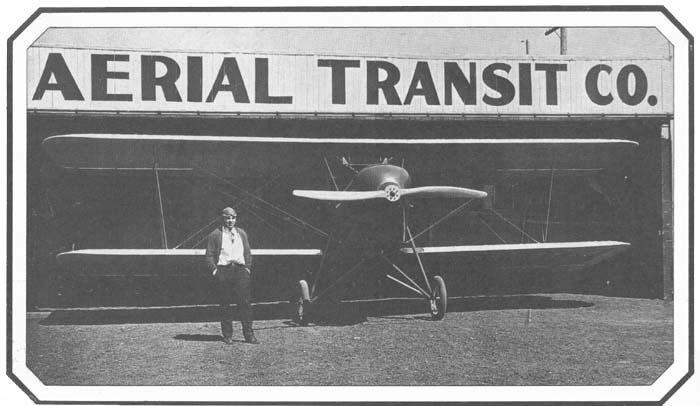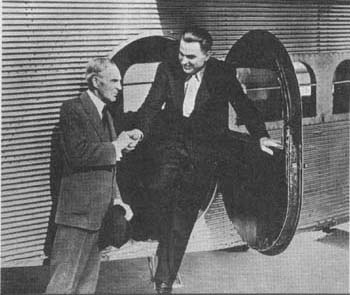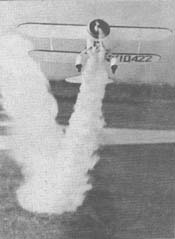|
Now the crowd is nearly out of its mind. Tex Rankin, one of the
greatest stunt pilots of all time, turns to the man next to him and shakes his
head in disbelief. "You'd never catch me doing that with that much airplane." Then he
turns back, eyes glued on the Ford Tri-Motor as Harold Johnson flying solo, climbs for
altitude to perform his most impossible maneuver of the show. All that has gone before,
has been merely to whet the appetite and provide a few candidates for coronaries.
 |
Typical wing-skidding landing during practice
session at Daytona Beach, Florida
|
 |
Famous for his low altitude pull-outs, John-
son eases the big bird out of a loop at a
delicate altitude while a Waco waits to see
what comes of it.
|
At 400 feet, Captain Johnson levels off then pulls the nose up sharply,
until the big tri-motor shudders into a hammerhead stall. Over the top she goes and into
a giant, arching spin toward oblivion, her engines popping softly, the wind screaming
along her corrugated surfaces. At 400 feet there is only room enough for a little over
one turn. The Ford rolls out at a very steep angle, and as Johnson seemingly recovers
from the spin and dives out of sight behind the bordering trees, the people are frantic.
They are certain that he has crashed . . . but where is the explosion?
Safe on the ground, Harold Johnson smiled. Always a showman, pleasing
the crowd was his foremost concern. If in the process, he also petrified them, it was a
minor by-product.
After pulling up from behind the trees still out of sight he had
wheeled the great silver ship around for a smooth one-wheel landing, touching the tip of
the wing on the dirt strip and raising clouds of dust. So went Harold S. Johnson's life
for ten years - from 1932 to 1942. During that time, he became known to millions as the
"King of the Fords", and no crown was ever worn more deservedly.

Captain Johnson's first aircaft, a WACO, in front of his
dealership hanger in 1930
|
Today, Harold Johnson recalls every detail of those fantastic flying
years as if they had happened last week. Born in Chicago, Illinois in 1910, his first
solo flight was made in 1929. The ship was a Waco and not long after soloing, Harold
formed the Aerial Transit Company and became a dealer for the Waco Airplane Co. Still,
he wanted to travel and decided that a dealership was just too pedestrian for him. As a
result, he launched himself into the barnstorming business, but with one important
reservation. He knew that if he went into an already overcrowded occupation, he had
better come up with something different . . . enter the Ford Tri-motor.

Rare photograph shows Johnson being congratulated by Henry Ford after putting on his
typically daredevil demonstration at the Ford plant in Dearborn, Michigan, during the
early thirties

|
This was a real first. It had never been done, much less attempted.
Stunting the big bird for air shows would really knock their eyes out. So in 1932, Harold
purchased a 4-AT Ford and set about learning how to wring it out. Rolling a six ton,
multi-engine airplane was a job that required more than guts, which Johnson had plenty of.
It also demanded new skills, new insights and new muscle coordination, as well as brawn.
Harold formed National Air Shows and with the Ford and other birds,
started zooming and looping over the towns and cities of the East and Middle West. He
soon discovered that wingtip scraping cost him a new tip every six months, and other
maintenance problems so plagued the fledgling company that Johnson was forced to
establish a certified CAA repair station on a Ford truckbed that followed the show.
 |
Agility of the venerable Ford
is demonstrated by inverted flight
|
For the next seven years Johnson, sponsored by SOHIO Oil, starred at
the National Air Races, stunting his Ford before thousands. And in 1931, he placed 2nd in
the Bendix Cross Country, flying a Lockheed Orion. However, since he wanted a swift,
maneuverable biplane to work in the shows and no factory built craft suited his fancy, he
built his own.
In 1937, he rolled out his Continental Special NR-10537. In this nimble,
Continental powered biplane, he would aileron roll straight for the ground, fly upside
down and generally warm up the crowd for the main event. Then he would land, taxi up to
the Ford, hop out of one plane and continue the show in the other. He never let the
people relax. His usual procedure would be a loop on take off, just to get everyone's
attention and, at times, Johnson would shut off one engine and do his routine on two
mills only.
TOP TO BOTTOM: Looping takeoff by Johnson in his Continental Special, then in modified
version. Johnson built this NR 10537, in original version (below) and aircraft
especially for stunt flying since no factory aircraft could satisfy his needs. A famous
duo . . . the Ford 4-AT and Monocoupe at Illinois airshow.
|

|

|

|

|
Johnson liked the Ford and the Ford liked Harold. Once, when he came
through Dearborn, Michigan, old Henry himself came out to see him perform and went away
amazed at his skill. The crusty old gentlemen considered Harold "a most talented and
daring young man."
Looping the Ford was Johnson's favorite maneuver and on one sortie
before a crowd of 15,000, he made 17 graceful loops, breaking his own world record of 16.
One of the more interesting brain-storms Harold devised, was to mount the Continental
Special atop the Ford, so that both aircraft could be flown to various air shows by one
pilot. Somehow, this project was put aside and never reached completion, although the
feat was accomplished later both by Great Britain and Germany.
Pearl Harbor brought the National Air Races to an end. Harold sold the
Ford and started ferrying Hudsons across the stormy Atlantic to England The loss rate on
those wartime delivery routes was nearly 50 percent then, and the missions were hairy,
most of them bedeviled by malfunctions of major proportions. After a year of this
incredible type flying, Johnson took on the less hazardous job of testing B-24's for
Ford's Willow Run plant. These fat birds were a far cry from the kind of ship he liked to
fly and he soon transferred to sunny California and Lockheed.
In 1944, he checked out in P-38s and began testing planes for delivery
to the combat zones. It was interesting and demanding work, with his day filled by 7 plus
G pullouts. Johnson also tested the 1049 Constellation and found, to his delight, that
the rate of roll was better than the P-38's . . . but there were more surprises in store.

At the close of hostilities, the P2V was a brand new idea at Lockheed
and there was a rush on to complete tests to prove to the Navy that the P2V was the bird
they wanted for anti-submarine patrolling. On a great flying day over Burbank, Johnson
was letting down the X model prototype, when the bomb door came loose, wrapped itself
around the tail, smashed the rudder and ripped three fourths of the vertical fin off the
aircraft. Johnson fought for control of the big ship, and heading out over the desert,
saved the plane and the P2V program by landing the aircraft at Edwards AFB. Thanks in
part to Harold Johnson's superb skill and piloting ability, the P2V is now the standard
anti-submarine patrol bomber for the free world.
During the war, Johnson was test pilot on B-24's at Ford's Willow
Run plant, flew P-38's for Lockheed and ferried Hudsons to England.
|

|
The hectic years were now coming to a close. With hostilities over in
the Pacific and military planes no longer being built in quantity, test pilots went
looking for other areas in which to apply their specialized talents. The King of the Ford
became a Beechcraft distributor in the east, but he had found a home in California and
was back a few years later to open a shop at Van Nuys Airport. Nevertheless, neither he
nor the tin goose could stay separated for long. There was another Ford in his
future . . . G.E. Moxon's Ford 5-AT at Santa Monica Airport . . . where Johnson now works
daily to restore it. And who knows, maybe a new generation of aviation buffs will see
Captain Harold Johnson fly the six ton airliner through a loop or roll? At any rate, a
Classic Airman and a Classic Airplane are back together again.
|
| By Bob O'Hare
|

